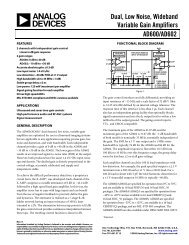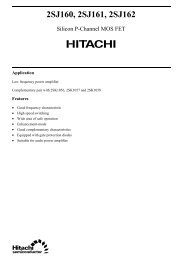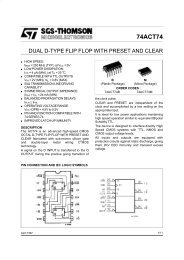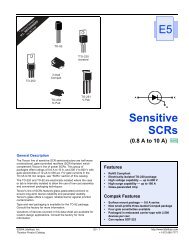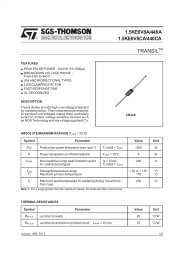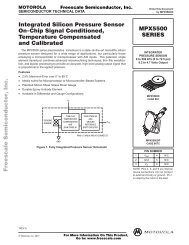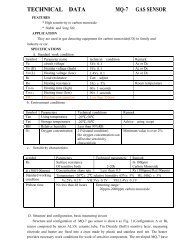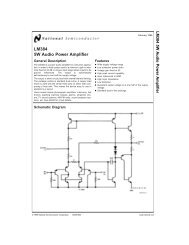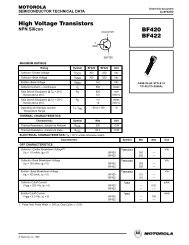TMS320F206 Digital Signal Processor (Rev. A) - Futurlec
TMS320F206 Digital Signal Processor (Rev. A) - Futurlec
TMS320F206 Digital Signal Processor (Rev. A) - Futurlec
Create successful ePaper yourself
Turn your PDF publications into a flip-book with our unique Google optimized e-Paper software.
<strong>TMS320F206</strong>DIGITAL SIGNAL PROCESSORSPRS050A – NOVEMBER 1996 – REVISED APRIL 1998Table 2. Legend for the ’F206 Internal Hardware Functional Block DiagramSYMBOL NAME DESCRIPTIONACCARAUAUXREGSBRCCALUCNFGREGIMRIFRINTMAccumulatorAuxiliary RegisterArithmetic UnitAuxiliary Registers0–7Bus Request<strong>Signal</strong>CarryCentral ArithmeticLogic UnitOn-Chip RAMConfigurationControl BitGlobal MemoryAllocationRegisterInterrupt MaskRegisterInterrupt FlagRegisterInterrupt-Mode Bit32-bit register that stores the results and provides input for subsequent CALU operations. Also includes shiftand rotate capabilitiesAn unsigned, 16-bit arithmetic unit used to calculate indirect addresses using the auxiliary registers as inputsand outputsThese 16-bit registers are used as pointers to anywhere within the data space address range. They areoperated upon by the ARAU and are selected by the auxiliary register pointer (ARP). AR0 can also be usedas an index value for AR updates of more than one and as a compare value to AR.BR is asserted during access of the external global data memory space. READY is asserted to the devicewhen the global data memory is available for the bus transaction. BR can be used to extend the data memoryaddress space by up to 32K words.Register carry output from CALU. C is fed back into the CALU for extended arithmetic operation. The C bitresides in status register 1 (ST1), and can be tested in conditional instructions. C is also used in accumulatorshifts and rotates.32-bit-wide main arithmetic logic unit for the TMS320C2xx core. The CALU executes 32-bit operations in asingle machine cycle. CALU operates on data coming from ISCALE or PSCALE with data from ACC, andprovides status results to PCTRL.If set to 0, the reconfigurable data dual-access RAM (DARAM) block B0 is mapped to data space; otherwise,B0 is mapped to program space.GREG specifies the size of the global data memory space.IMR individually masks or enables the seven interrupts.The 7-bit IFR indicates that the <strong>TMS320F206</strong> has latched an interrupt from one of the seven maskableinterrupts.When INTM is set to 0, all unmasked interrupts are enabled. When INTM is set to 1, all maskable interruptsare disabled.INT# Interrupt Traps A total of 32 interrupts by way of hardware and/or software are available.ISCALEMPYMSTACKInput Data-ScalingShifterMultiplierMicro Stack16 to 32-bit barrel left-shifter. ISCALE shifts incoming 16-bit data 0 to16 positions left, relative to the 32-bitoutput within the fetch cycle; therefore, no cycle overhead is required for input scaling operations.16 × 16-bit multiplier to a 32-bit product. MPY executes multiplication in a single cycle. MPY operates eithersigned or unsigned 2s-complement arithmetic multiply.MSTACK provides temporary storage for the address of the next instruction to be fetched when programaddress-generation logic is used to generate sequential addresses in data space.MUX Multiplexer Multiplexes buses to a common inputNPARNext ProgramAddress RegisterNPAR holds the program address to be driven out on the PAB on the next cycle.OSCALEPARPCPCTRLOutputData-ScalingShifterProgram AddressRegisterProgram CounterProgramController16 to 32-bit barrel left-shifter. OSCALE shifts the 32-bit accumulator output 0 to 7 bits left for quantizationmanagement and outputs either the 16-bit high- or low-half of the shifted 32-bit data to the Data-Write DataBus (DWEB).PAR holds the address currently being driven on PAB for as many cycles as it takes to complete all memoryoperations scheduled for the current bus cycle.PC increments the value from NPAR to provide sequential addresses for instruction-fetching and sequentialdata-transfer operations.PCTRL decodes instruction, manages the pipeline, stores status, and decodes conditional operations.8 POST OFFICE BOX 1443 • HOUSTON, TEXAS 77251–1443



